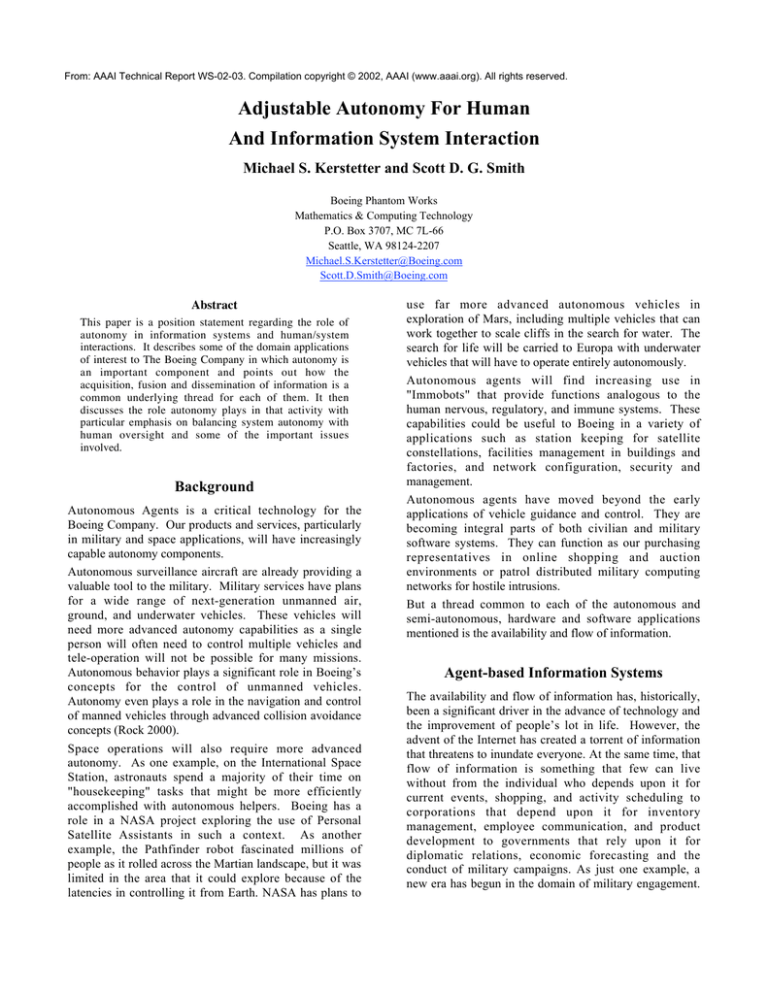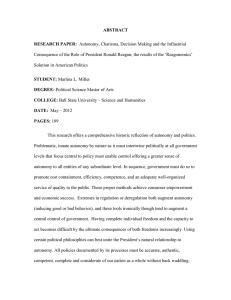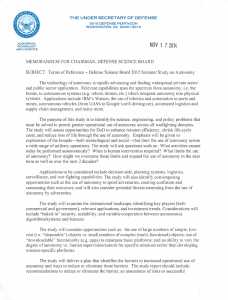
From: AAAI Technical Report WS-02-03. Compilation copyright © 2002, AAAI (www.aaai.org). All rights reserved.
Adjustable Autonomy For Human
And Information System Interaction
Michael S. Kerstetter and Scott D. G. Smith
Boeing Phantom Works
Mathematics & Computing Technology
P.O. Box 3707, MC 7L-66
Seattle, WA 98124-2207
Michael.S.Kerstetter@Boeing.com
Scott.D.Smith@Boeing.com
Abstract
This paper is a position statement regarding the role of
autonomy in information systems and human/system
interactions. It describes some of the domain applications
of interest to The Boeing Company in which autonomy is
an important component and points out how the
acquisition, fusion and dissemination of information is a
common underlying thread for each of them. It then
discusses the role autonomy plays in that activity with
particular emphasis on balancing system autonomy with
human oversight and some of the important issues
involved.
Background
Autonomous Agents is a critical technology for the
Boeing Company. Our products and services, particularly
in military and space applications, will have increasingly
capable autonomy components.
Autonomous surveillance aircraft are already providing a
valuable tool to the military. Military services have plans
for a wide range of next-generation unmanned air,
ground, and underwater vehicles. These vehicles will
need more advanced autonomy capabilities as a single
person will often need to control multiple vehicles and
tele-operation will not be possible for many missions.
Autonomous behavior plays a significant role in Boeing’s
concepts for the control of unmanned vehicles.
Autonomy even plays a role in the navigation and control
of manned vehicles through advanced collision avoidance
concepts (Rock 2000).
Space operations will also require more advanced
autonomy. As one example, on the International Space
Station, astronauts spend a majority of their time on
"housekeeping" tasks that might be more efficiently
accomplished with autonomous helpers. Boeing has a
role in a NASA project exploring the use of Personal
Satellite Assistants in such a context. As another
example, the Pathfinder robot fascinated millions of
people as it rolled across the Martian landscape, but it was
limited in the area that it could explore because of the
latencies in controlling it from Earth. NASA has plans to
use far more advanced autonomous vehicles in
exploration of Mars, including multiple vehicles that can
work together to scale cliffs in the search for water. The
search for life will be carried to Europa with underwater
vehicles that will have to operate entirely autonomously.
Autonomous agents will find increasing use in
"Immobots" that provide functions analogous to the
human nervous, regulatory, and immune systems. These
capabilities could be useful to Boeing in a variety of
applications such as station keeping for satellite
constellations, facilities management in buildings and
factories, and network configuration, security and
management.
Autonomous agents have moved beyond the early
applications of vehicle guidance and control. They are
becoming integral parts of both civilian and military
software systems. They can function as our purchasing
representatives in online shopping and auction
environments or patrol distributed military computing
networks for hostile intrusions.
But a thread common to each of the autonomous and
semi-autonomous, hardware and software applications
mentioned is the availability and flow of information.
Agent-based Information Systems
The availability and flow of information has, historically,
been a significant driver in the advance of technology and
the improvement of people’s lot in life. However, the
advent of the Internet has created a torrent of information
that threatens to inundate everyone. At the same time, that
flow of information is something that few can live
without from the individual who depends upon it for
current events, shopping, and activity scheduling to
corporations that depend upon it for inventory
management, employee communication, and product
development to governments that rely upon it for
diplomatic relations, economic forecasting and the
conduct of military campaigns. As just one example, a
new era has begun in the domain of military engagement.
Conflicts will no longer be between large masses of
opposing forces on a battlefield, but will instead be
dominated by numerous targeted strikes on prearranged
targets by air forces and small, fast-moving ground forces.
The success of such engagements will rely on accurate,
timely intelligence. But the information resources
available to the military are numerous, diverse in nature
and geographically dispersed. The major technical
challenge facing the military is that of gathering
information from its diverse resources and presenting the
right information in a useful form, where it is needed,
when it is needed. We in Mathematics and Computing
Technology (M&CT) wish to explore the role of
autonomy in the acquisition and dissemination of the very
information that describes the environment and forms the
context within which more specific hardware and
software applications operate.
Simple distributed client-server technology is inadequate
to the task of gathering, fusing and presenting the right
information at the right time. A distributed network of
cooperative software agents and associated enabling
technologies is required to provide the sophisticated
computational capability necessary to meet the
information and knowledge management needs of the
military. Software agents of this nature possess
sophisticated characteristics. They have the ability to
traverse the network in response to the requirements of
their task objective or state of their operational
environment. Sophisticated agents possess the ability to
coordinate with other entities in the system to complete
subtasks in a cooperative manner. They can negotiate
with other entities for scarce or time-critical resources.
Agents are able to engage in complex conversations with
other agents and with humans with a high degree of
semantic content. They contain complex algorithms
enabling fully- or semi-autonomous operation.
Increasingly, the systems that Boeing builds and uses are
limited by the human role. This trend requires more
sophisticated autonomy technology.
Adjustable Autonomy in Information
Systems
One aspect of the use of autonomy in the context of
information systems, one that is central to working with
autonomous agents with this degree of sophistication and
interoperability, is timely and efficient communication
and interaction between humans and agents. We believe
that it is important to the goal of Anytime/Anywhere
information systems to investigate and demonstrate
methods of communication and interaction between
humans and semi-autonomous software agents, with a
particular focus on enabling “adjustable autonomy” for
agents.
Agents are the natural evolution of object programming
technology and are typically distinguished from
“ordinary” objects by possessing one or more of the
characteristics of adaptability, cooperation or autonomy.
The ability to perform, without supervision, functions that
would normally be performed by humans is a major
reason for the interest in agent technology. Many
autonomous systems are designed with fixed assumptions
about what level of autonomy is appropriate to their tasks.
But complete automation of complex tasks is sometimes
impossible to achieve and often it isn’t even desired. They
execute their instructions without taking into account that
fact that the optimal level of autonomy may vary by task
and over time, or that unforeseen events may prompt a
need for either the human or the system to take more
control. The gathering, analysis and delivery of data and
knowledge in the information systems of the future will
very likely need to be performed in cooperation with
humans and with other autonomous systems.
Furthermore, these heterogeneous cooperating entities
may operate at different levels of sophistication and with
dynamically varying degrees of autonomy.
Autonomy, including in the context of agents, has been a
major focus of academic research for several years. In
recent years, a significant portion of autonomy research
has moved in the direction of adjustable autonomy, also
known as mixed-initiative autonomy. But most of the
work has been performed in the context of robotic control
and autonomy. In general, software autonomy implies the
ability for a software program to receive a goal to
achieve, devise a plan for achieving that goal, define a set
of action primitives sufficient to carry out the plan, and
oversee the execution of the plan. This implies a series of
significant questions that need to be answered:
What is the role of autonomy in information systems?
How can autonomous behavior be employed to enhance
the function of information systems, the tasks they need to
perform and amount of oversight required by a human
operator? Of particular interest, in the context of this
whitepaper, is the access, acquisition, fusion and timely
dissemination of the information necessary for the
execution of domain-specific applications.
What are the appropriate representations for stating a
goal to be accomplished? Autonomous behavior
generally manifests itself in the process of achieving a
goal. The goal may be presented to the system by a
human or by another software agent. This implies a need
to represent goals in a manner that is understandable and
processable by both humans and machines.
What mechanisms can be used to go from goal
representation to plan to actions? These mechanisms
might be constrained by certain factors such as required
response time, security, available resources or necessary
interaction with a human operator.
How is the appropriate level of autonomy determined?
The goal of adjustable autonomy is to make sure that for
any given situation and task the system is operating at the
correct boundary between the initiative of the user and
that of the system. People want to maintain that boundary
at the optimum point in the tradeoff curve that minimizes
their need to attend to interaction with the system while
providing them a sufficient level of comfort that nothing
will go wrong. The actual adjustment of autonomy level
can be performed by a person or a program, or by the
agent itself.
How is decision authority transitioned between human
and machine? A system’s level of autonomy can be
varied along several dimensions such as: 1) type or
complexity of the commands it is permitted to execute, 2)
which of its subsystems may function autonomously, 3)
circumstances under which the system will override
manual control (e.g., if a human operator is about to place
classified information in an unclassified area), and 4)
duration of autonomous operation. Different dimensions
may require different transition mechanisms and choice
representations.
What kind of generic programmatic support for
adjustable autonomy can be provided in an agent-based
architectural framework? It isn’t expected that all agents
developed for Boeing applications will be developed by a
centralized “agent development organization” or even by
software engineers with years of agent development
experience. Agent development frameworks providing
support for advanced agent-related capabilities is an
important component of Boeing’s agent development
strategy. Inclusion in a framework of “generic”
algorithms supporting the implementation of autonomy in
agents would be an important addition, if possible.
It is our goal at M&CT to pursue projects aimed at
investigating these and other questions related to the use
of autonomous agents in Boeing products and processes.
Summary
This paper has laid out the general framework for
investigating the use of adjustable autonomy in
information gathering, fusion and dissemination and some
of the important questions that need to be answered.
The use of autonomy in this context will not be an easy
task. Ideally, the system will function with as much
autonomy as possible, however, achieving results of
sufficient accuracy and reliability to overcome the human
operator’s reluctance to “turn up the autonomy knob” will
be difficult.
Accuracy and reliability are further complicated by a
requirement for increasing breadth of information
covered. Imagine a small system with tightly focused
topical information requirements. The acquisition and
fusion of information from different sources is likely to
yield high-quality results. But imagine a large, enterprisewide system with requirements for information covering a
broad range of topics. Semantic differences are much
more likely to occur with a corresponding degradation in
result quality. Data fusion and the semantic integration of
information from multiple sources are research topics in
their own right, but they have direct implications on the
successful implementation of autonomy in this context.
Nevertheless, as these questions are answered, autonomy
in information acquisition and dissemination will enable
efficient and effective system integration. Ultimately this
will lead to more sophisticated unmanned vehicles,
enterprise systems and other domain-specific applications.
About M&CT
The Boeing Phantom Works Mathematics and Computing
Technology (M&CT) organization has an active research
effort in agent technology that has been at the forefront of
the field for several years and an established core of
technology experts. The work of the M&CT agent
research team has been published in numerous highly
respected technical journals and books. They have
developed and continue to enhance a research-level
framework for agent-based systems, Knowledgeable
Agent-oriented System (KAoS). The M&CT Agents
Research Team has a contract history of external research
efforts for and with government agencies and various
universities across the country.
In addition to agent-oriented knowledge and experience,
M&CT is equally capable in the enabling technologies
that give an agent its “intelligence”. M&CT represents an
internationally recognized group of experts in a wide
range of technical fields, including those agent-enabling
technologies that are necessary for the development of
sophisticated, highly-capable, domain-specific agent
systems. M&CT has ongoing research in areas such as:
autonomous systems, knowledge management and
representation, semantic integration and ontologies,
information access and security, collaboration
technologies, reasoning methods, and more.
Both authors are Associate Technical Fellows of The
Boeing Company. Mr. Kerstetter is the lead for agent
research activities in M&CT and Mr. Smith is the lead for
autonomy research activities in M&CT.
References
Rock, Dennis. 2000. Agent Autonomy Adjustment for
Mid-air Collision Avoidance Automation. In Proceedings
of the American Institute for Astronautics and
Aeronautics Guidance, Navigation, and Control
Conference, August 10-12, 2000, Denver, Colorado.
AIAA Paper: GNC-35, 2000-4480





